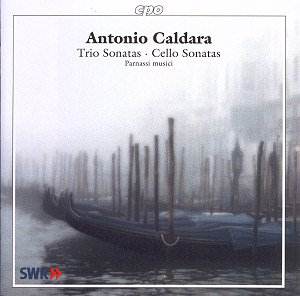Caldara is best known for his extensive vocal works;
the operatic and the sacred were his metier though he was a trained
cellist. Nevertheless his Op 1 consisted of a chamber music calling
card – twelve "Suonate a Tre" for two violins and a basso
continuo (a cello), published in Venice in 1693 and probably intended
for church performance. Though his later eminence was to mark him out
as a prize catch in Dresden Caldara’s earlier experience at St Marks
equipped him for a versatile career in Italian operatic life.
In CPO’s fine disc we have five of the Op 1 Trio Sonatas
– numbers 1, 2, 5, 7 and 10. Some, if not all, doubtless predated the
publication year of 1693 but their emergence did mark a decisive shift
in his reputation. His strongly contrapuntal writing is both admirable
and sophisticated; the use of suspension harmony attractive and anticipatory.
There is gravity and intensity in the opening Adagio of the F minor
and a charitable starkness as well as simplicity in the same Trio’s
subsequent slow movement. Galant expressivity vies with little hesitancies
in the opening of the G major, No 2 of the set. The elegantly ascending
and descending violin lines of the Allegro are as colourful and melodically
exciting as is the saturnine cello pizzicati in the Grave. The E minor
opens like a Chaconne but the winding, aspirant ascension of violins
adds piquancy to the texture of the succeeding Adagio. Amusing and technically
adroit is the way in which Caldara allows the winding down of material
in the Allegro second movement before propulsively engaging a drama
laced final chordal flourish. The Adagio of this work is rather more
densely opulent, with some expressive trills.
Six years later he was appointed as Court music director
by the Duke of Mantua. Dating from this period is his A flat major Chiacona,
the conclusion of that cycle and an impressive work in its own right.
It involves considerable harmonic modulation and strong interplay between
the two violins; whilst the thematic material may not be as obviously
impressive as the Chaconne by Corelli, Caldara plays out the implications
of the writing with real ingenuity.
Toward the end of his career Caldara was commissioned
by Count Rudolf of Schönbrun to write an extensive series of works
for the cello – and he wrote seventeen sonatas and a concerto altogether.
Both Sonatas here are typical four movement creations but are unusually
sophisticated. The A minor for example handles its material with an
ease and confidence which marks Caldara’s total absorption of the form;
the galant wit and poise that informs, say, the Allegro e Spirituoso
are testament to a confluence of technical eloquence and expressive
charm.
The German period instrument group Parnassi musici
– who have recorded Albinoni and the little known Domenico Gallo to
acclaim – continue their laudable exploration of the repertoire. These
are sensitively shaped, instrumentally compelling performances recorded
in a winningly sympathetic acoustic. Warmly recommended.
Jonathan Woolf
